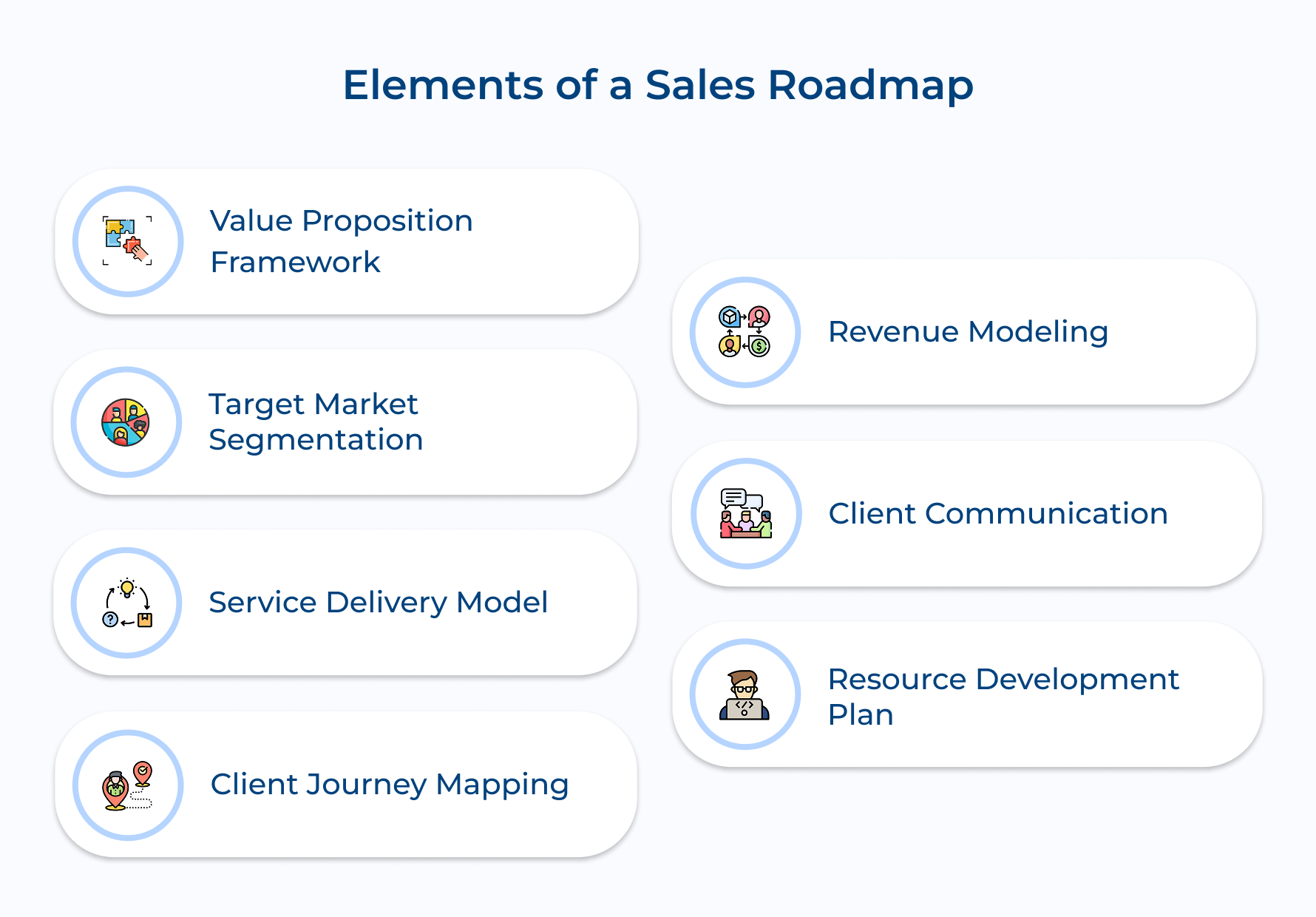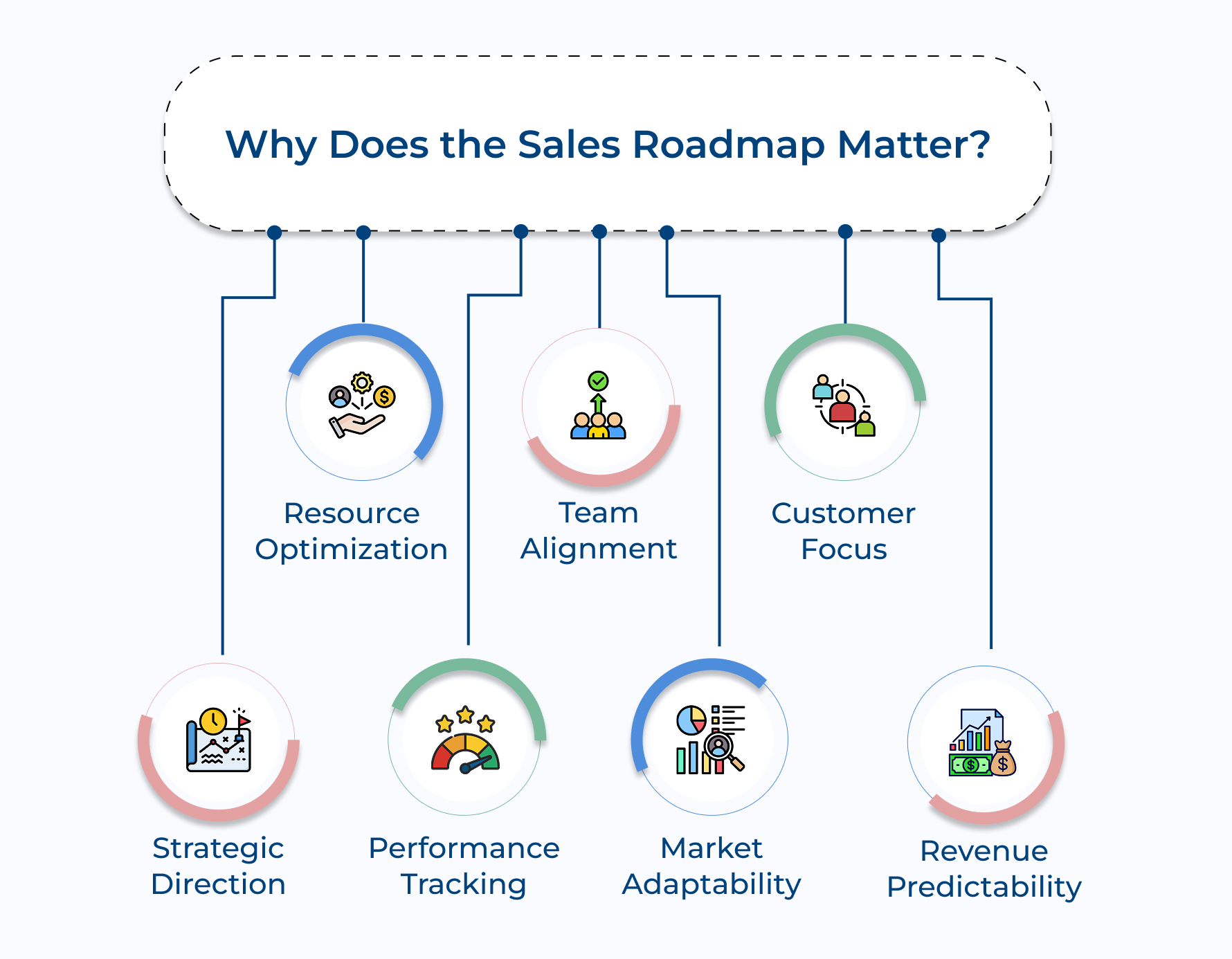Guide to Building Effective Sales Roadmap in 6 Simple Steps

Key Highlights:
- A sales roadmap provides clear direction, aligning daily tasks with long-term goals, and ensuring teams stay focused on priorities.
- It optimizes resource allocation, preventing waste while helping teams work smarter and not harder.
- The roadmap enables performance tracking, offering measurable metrics to identify successful strategies and areas for continuous improvement.
Is your sales team struggling with inconsistent performance, lack of direction, or missed revenue targets? It’s a common challenge when sales strategies are scattered and unorganized.
Without a clear plan, it’s easy for teams to feel overwhelmed, miss opportunities, and end up frustrated by inefficiencies.
The solution? A well-crafted sales roadmap. It provides your team with a clear, actionable path, aligns everyone’s efforts, as well as optimizes processes to focus on what matters.
We’ll guide you through creating a sales roadmap that drives measurable results and unlocks your team’s full potential.
What is a Sales Roadmap?
A sales roadmap is a strategic planning document or visual guide that outlines an organization’s sales objectives, strategies, and the specific steps needed to achieve revenue goals over a defined period. It serves as a dynamic blueprint that aligns sales activities with broader business objectives while providing clear direction for the sales team.
Well-crafted product roadmaps help organizations prioritize resources effectively, identify potential challenges early, and adapt strategies as market conditions change. It also ensures that all stakeholders, from sales representatives to executive leadership, are aligned on goals and expectations, reducing confusion while improving operational efficiency.
Key objectives:
- Revenue growth: Set specific, measurable targets for increasing sales revenue across different market segments and product lines.
- Market penetration: Define strategies to expand market share in existing markets or enter new geographical territories.
- Customer acquisition and retention: Establish clear goals for acquiring new customers while maintaining and growing relationships with existing ones.
- Sales process optimization: Identify and implement improvements in sales methodologies, tools, as well as technologies to enhance efficiency.
Key Elements of a Sales Roadmap
A sales roadmap is a strategic guide that outlines your team’s goals, priorities, and the steps needed to achieve them. Let us understand its key elements and how it helps your overall performance.
Value Proposition Framework
Define your services clearly to address client pain points and deliver measurable results. Highlight your unique expertise, differentiators as well as the benefits that make you stand out.
Target Market Segmentation
Understand your ideal clients by analyzing industries, company sizes, and specific needs. Identify decision-makers while mapping their buying behaviors for targeted outreach.
Service Delivery Model
Outline a structured approach to delivering services, including availability of resources, timelines, and quality checks. Ensure processes are scalable yet flexible to meet client needs.
Client Journey Mapping
Visualize every client interaction from the first engagement to long-term management. Plan communication, milestones, and feedback points to enhance the experience.
Revenue Modeling
Build financial projections with pricing strategies, service packages, and contract options. Factor in costs, utilization, and profitability for sustainable growth.
Client Communication
Create regular update schedules, progress reports, and feedback loops. Transparency along with clear expectations strengthen client relationships.
Resource Development Plan
Invest in your team’s growth through training, certifications, and skill-building. Stay aligned with market trends to remain competitive.
Steps to Creating a Sales Roadmap
Creating a sales roadmap involves a structured approach to align your team’s goals and strategies. By following key steps, you can build a clear path to drive success and achieve consistent growth.
1. Analyze Current Market Position
Understanding your company’s current standing is crucial for creating an effective sales roadmap. Here’s how to evaluate your market position and use the insights to drive informed decisions while also identifying opportunities for future projects.
1. Comprehensive Sales Performance Review
- Assess your sales metrics, market share, and team capabilities.
- Identify strengths/weaknesses in your current processes.
- Evaluate how your sales efforts align with market trends and customer preferences.
2. Market and Competitor Analysis
- Conduct quarterly competitor analysis focusing on pricing, features, market share, etc.
- Include emerging competitors and industry disruptors in your review.
- Create detailed competitive matrices to visualize opportunities.
3. Customer Insights and Feedback
- Implement regular customer feedback surveys to understand their needs and preferences.
- Analyze sales data to spot trends and areas for improvement.
- Use insights to shape upcoming projects and refine your strategies.
Actionable Resource Planning
- Align your findings with project resource allocation for maximum efficiency.
- Set realistic goals based on identified market gaps and customer needs.
- Use the analysis to prioritize strategies that yield the best results.
By following these steps, you’ll gather valuable insights to create a strong foundation for your sales roadmap, driving sustainable success.
2. Define Clear Sales Objectives
Clear and measurable goals are essential for guiding your sales team while also aligning their efforts with broader business priorities. Here’s how to set effective objectives,
1. Define Specific and Measurable Goals
- Set clear targets for revenue, market share, and customer satisfaction.
- Include both quantitative goals (e.g., revenue growth) and qualitative goals (e.g., improved brand positioning).
- Break objectives into short-term (quarterly), medium-term (annual), and long-term (3-5 years) horizons.
2. Provide Focus and Alignment
- Ensure everyone works toward common goals by creating a shared sense of purpose.
- Use well-defined targets to measure progress and adjust strategies as needed.
- Align sales objectives with overall business priorities to maximize resource efficiency.
3. Break Down Goals for Better Clarity
- Divide annual objectives into quarterly and monthly targets for easier tracking.
- Assign specific metrics for different sales channels and team members.
- Implement cascading goals, where organizational targets break down into departmental, team, and individual objectives.
4. Leverage Goal-Setting Frameworks
- Use proven methods like OKRs (Objectives and Key Results) or SMART goals to create actionable targets.
- Balance leading indicators (activity-based metrics) with lagging indicators (results-based metrics) for a holistic view of progress.
Pro tips:
- Develop a balanced scorecard that includes customer satisfaction and sales efficiency metrics.
- Create individual dashboards linked to team objectives for accountability.
- Update dashboards weekly and hold monthly review sessions to stay on track as well as refine tactics.
3. Develop Sales Strategies
Your sales strategy outlines the methods your team will use to achieve objectives, ensuring alignment as well as efficiency. But, how to craft strategies that work? With the below steps.
1. Define Clear Approaches
- Identify targeting strategies, sales channels, and customer engagement methods.
- Include frameworks like sales methodologies, pricing strategies, and territory planning.
- Balance acquisition and retention strategies to meet both short-term as well as long-term goals.
2. Strategic Planning for Better Outcomes
- Use insights from previous strategies to refine your approach and avoid repeated pitfalls.
- Align strategies with your team’s strengths and allocate them effectively.
- Ensure consistency across all efforts to differentiate from competitors and build sustainable advantages.
3. Actionable Tactics
- Map customer journeys and define sales processes tailored to different market segments.
- Create plans for lead generation, qualification, and conversion that align with project requirements.
- Develop account-based marketing strategies and detailed sales playbooks for various customer scenarios.
Actionable Tips
- Build detailed buyer personas, considering pain points and decision-making processes.
- Include specific scripts, email templates, and objection-handling techniques in your sales playbook.
- Regularly monitor progress and adjust tactics based on real-time data.
4. Create Implementation Timeline
A clear sales timeline helps you stay on track and ensures all activities align with your objectives.
1. Create a Detailed Schedule
- Break down your plan into specific phases with clear milestones and deadlines.
- Include dependencies, resource allocation schedules, training periods, and launch dates.
- Add contingency buffers to accommodate market changes and unforeseen delays.
2. Maintain Structure and Momentum
- Timelines provide structure and urgency, ensuring that your team stays focused.
- Proper scheduling helps manage resources efficiently, preventing conflicts and delays.
- Well-timed activities create coordination with other departments, enabling smoother execution.
3. Quarterly Sprints and Checkpoints
- Break down annual goals into quarterly sprints with clear deliverables.
- Set checkpoints to review progress, adjust strategies, and adapt to market shifts.
- Use tools like Gantt charts and project management software to track key initiatives.
Tips to Consider
- Leverage project management software to track initiatives, dependencies, and milestones.
- Schedule biweekly progress reviews and monthly strategic meetings to ensure alignment as well as timeline adherence.
5. Assign Roles and Responsibilities
Clear role definition is key to keeping your sales strategy organized and efficient. How to clarify responsibilities within your team, you ask?
1. Clarify Responsibilities
- Define who is responsible for specific tasks, sales territories, and key outcomes.
- Create detailed job descriptions and ensure everyone knows their role within the strategy.
- Assign decision-making authority levels and cross-functional collaboration requirements.
2. Enhance Team Efficiency
- Clear responsibilities eliminate overlap and ensure nothing is missed.
- It helps each team member understand their unique contribution to the overall success.
- Proper role assignment leads to better resource management, minimizes conflicts, and drives performance.
3. Use Structured Systems
- Implement RACI matrices to clarify roles, decision-making, and involvement in major initiatives.
- Develop role-based KPIs and performance metrics to measure individual as well as team contributions.
- Set up career progression paths and skill development plans to support growth.
Actionable Tips
- Create weekly task lists with clear owners, deadlines, and success criteria for each team member.
- Include collaboration requirements and dependencies to ensure everyone is aligned.
6. Establish Monitoring Systems
Tracking progress and measuring results is key to keeping your sales strategy on track. Let’s learn how to monitor as well as evaluate your performance.
1. Set Up Monitoring Systems
- Use sales analytics platforms/reporting systems to track progress and results.
- Establish dashboards to visualize key metrics and KPIs, making it easier for teams to follow along.
- Implement regular review cycles and feedback loops to ensure you’re staying on course.
2. Enable Quick Responses and Continuous Improvement
- Monitoring helps you spot issues and opportunities early, allowing for faster responses.
- Regular tracking keeps the team focused on key objectives and ensures accountability.
- Use data to drive decision-making and identify areas for continuous improvement.
3. Leverage Predictive Analytics
- Use predictive tools to forecast sales and analyze trends for better decision-making.
- Create automated performance reports with trend analysis and exception alerts.
- Establish monthly performance reviews to track progress, highlight issues, and set action items.
Pro Tips
- Set up automated daily/weekly sales performance reports for quick insights.
- Use visualization tools to present data clearly and make decision-making easier.
- Hold regular performance reviews with standardized templates to track progress and follow through.
Why Does the Sales Roadmap Matter?
A sales roadmap provides a clear direction and actionable steps to achieve your sales objectives as well as long-term business goals. Learn how it matters in the long run.
Strategic Direction
A well-crafted sales roadmap keeps your team focused and aligned with long-term business goals. Connecting daily tasks with broader objectives helps avoid distractions and ensures everyone is working toward the same priorities.
Resource Optimization
With a clear plan, you can allocate resources like time, money, and human capital more effectively. This prevents wastage, maximizes ROI, and helps your team work smarter, not harder.
Performance Tracking
Sales roadmaps set clear metrics and milestones, so success is measurable. They allow teams to quickly spot what’s working, what’s not, and where adjustments are needed for continuous improvement.
Team Alignment
When everyone shares the same vision and goals, teamwork flourishes. A sales roadmap reduces friction between departments, encourages collaboration, and keeps everyone moving in the same direction.
Market Adaptability
A strategic roadmap keeps you flexible and responsive to market changes. It allows quick evaluations of new opportunities and threats, making it easier to adjust strategies when necessary.
Customer Focus
By mapping out the customer journey and touchpoints, a sales roadmap helps ensure a consistent, exceptional experience. This builds stronger, long-lasting customer relationships.
Revenue Predictability
With well-defined targets and strategies, revenue forecasting becomes more accurate. It leads to more confident financial planning and greater stakeholder trust in your growth potential.
Driving Success: Your Sales Roadmap as a Gateway to Growth
As we’ve explored, a sales roadmap is your organization’s compass in the complex landscape of modern business. It transforms abstract goals into achievable milestones, aligns team efforts with company objectives, and provides the structure needed for sustainable growth.
Success in sales isn’t about random acts of selling—it’s about strategic planning, systematic execution, and continuous adaptation. Your sales roadmap embodies these principles, serving as both a strategic guide and a tactical playbook for your team’s success.
Remember, the journey to sales excellence is ongoing. Keep your roadmap dynamic, your goals clear, and your team engaged. With these elements in place, you’re well-equipped to navigate any market challenges and capture the opportunities that lie ahead.
Limit time — not creativity
Everything you need for customer support, marketing & sales.
Neeti Singh is a passionate content writer at Kooper, where he transforms complex concepts into clear, engaging and actionable content. With a keen eye for detail and a love for technology, Tushar Joshi crafts blog posts, guides and articles that help readers navigate the fast-evolving world of software solutions.


